Electrical current is the flow of charged particles. The electric current flows through a wire the same way as how water moves in a river. The electricity is nothing but the flow of electrons. 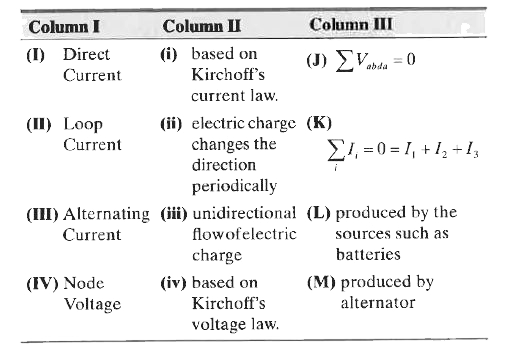
What does the graph signify? 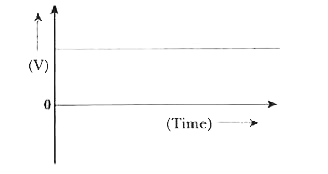
(II) (iv) (J)
(IV) (i) (M)
(I) (ii) (L)
(III) (iv) (K)
The correct Answer is:D
Step by step video, text & image solution for Electrical current is the flow of charged particles. The electric current flows through a wire the same way as how water moves in a river. The electricity is nothing but the flow of electrons. What does the graph signify? by Physics experts to help you in doubts & scoring excellent marks in Class 12 exams.
Topper's Solved these Questions
- BOOK - RESNICK AND HALLIDAYCHAPTER - CURRENT AND RESISTANCEEXERCISE - Practice Questions (Integer Type)3videos
CURRENT AND RESISTANCE
- BOOK - RESNICK AND HALLIDAYCHAPTER - CURRENT AND RESISTANCEEXERCISE - Practice Questions (Linked Comprehension)5videos
CURRENT AND RESISTANCE
- BOOK - RESNICK AND HALLIDAYCHAPTER - CIRCULAR MOTIONEXERCISE - CHECK POINTS6videos
CIRCULAR MOTION
- BOOK - RESNICK AND HALLIDAYCHAPTER - ELASTICITYEXERCISE - PRACTICE QUESTIONS (Integer Type)3videos
ELASTICITY
Similar Questions
Knowledge Check
- Question 1 - Select One
Electrical current is the flow of charged particles. The electric current flows through a wire the same way as how water moves in a river. The electricity is nothing but the flow of electrons.
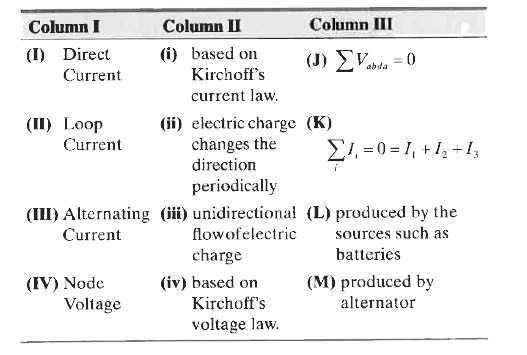
What does the circuit diagram signify? A(III) (i) (K)B(IV) (i) (J)C(III) (iii) (M)D(III) (ii) (M)
A(III) (i) (K)B(IV) (i) (J)C(III) (iii) (M)D(III) (ii) (M) - Question 2 - Select One
Electric current is the flow of _____ .
AElectronsBProtonsCNeutronsDPositrons - Question 3 - Select One
Electrical current is the flow of charged particles. The electric current flows through a wire the same way as how water moves in a river. The electricity is nothing but the flow of electrons. There are two main combinations of resistors in circuit, that is series and parallel. In the given table, Column I shows different combinations of resistors, Column II shows voltages of different arrangements of resistors and Column III shows currents and voltage division needed or not in different arrangements of resistors.
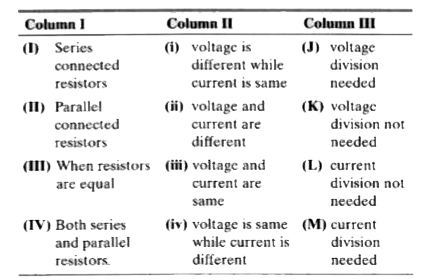
When does the current division problem arise?A(III) (i) (K)B(IV) (i) (J)C(III) (iii) (M)D(II) (iv) (M)
Electrical current is the flow of charged particles. The electric current flows through a wire the same way as how water moves in a river. The electricity is nothing but the flow of electrons. There are two main combinations of resistors in circuit, that is series and parallel. In the given table, Column I shows different combinations of resistors, Column II shows voltages of different arrangements of resistors and Column III shows currents and voltage division needed or not in different arrangements of resistors.
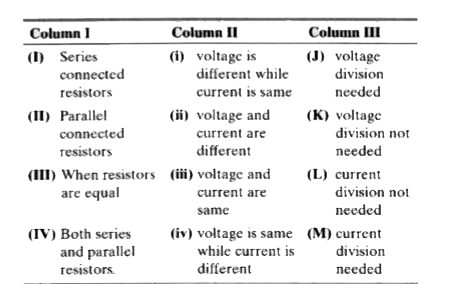
When does the voltage division problem arise?View SolutionElectrical current is the flow of charged particles. The electric current flows through a wire the same way as how water moves in a river. The electricity is nothing but the flow of electrons. There are two main combinations of resistors in circuit, that is series and parallel. In the given table, Column I shows different combinations of resistors, Column II shows voltages of different arrangements of resistors and Column III shows currents and voltage division needed or not in different arrangements of resistors.
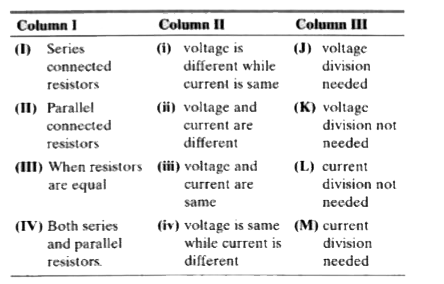
When there is no voltage division problem arise?View SolutionElectric current can flow through
View SolutionElectric current is the flow of _____ .
View SolutionElectric current flows
View Solution


